When I’m shooting a planetary grouping in twilight, should I set my digital camera to a low or a high ISO value?

The easiest way to answer this question is to make test exposures of a skyline during twilight, with or without planets. Try all the available ISO values (analogous to film speeds). See which image looks best under close examination, preferably on a computer monitor.
A digital camera’s inherent electronic noise arises from several sources within the camera, and it gives images a grainy or mottled appearance. It is a problem dogging all photographers who use exposures longer than about 1/4 or 1/2 second. My experience suggests that various cameras, even those of the same brand, handle electronic noise differently. While the shorter exposures made possible by a higher ISO setting may contain less noise from one source, they may contain more from another. Fortunately, test exposures with a digital camera are a snap to make on any evening, and they don’t rack up the expenses of tests made with photographic film.
If possible, you should also set your camera to save its images in an uncompressed format, such as TIFF, rather than any of the compressed formats (JPEG, for example). This will better preserve subtle gradations in brightness and help prevent the sky from appearing mottled.
— Dennis di Cicco
 0
0







Comments
You must be logged in to post a comment.